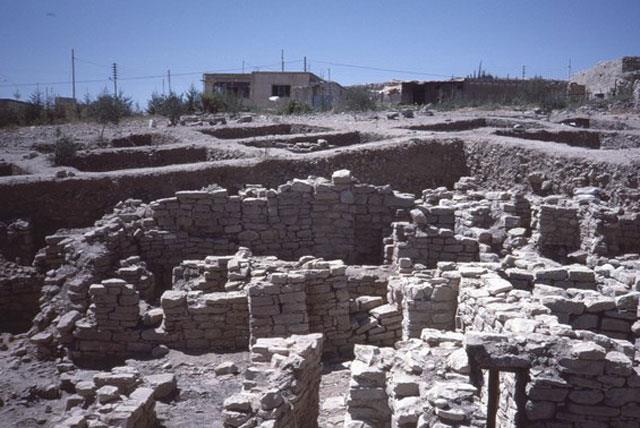
Basta: About Social, Reproductive Practices During Neolithic Era
Instead of a cemetery, the deceased would be buried under the floors of their households and this concept in Basta spread through the region.
As a civilisation that predates the invention of pottery, the household items that were found in Basta were made of stone and bones from which grinding tools and mills were created, while flint was used to make arrowheads. Animal dolls such as a sitting deer, the head of a bull or a cow, the head of a bear and the head of a ram, were also found, which may have religious meaning.
In their highest point, Basta became a regional centre of trade and“industrial” production of handmade tools. Thanks to the domestication, trade and agriculture, Basta reached the population of at least 1000 people, which was one of the most populated settlements in that time along with neighbouring Beidha.
“The transition from foraging to farming is one of the most fundamental changes in human history, sustained by innovative economic strategies and accompanied particularly by large-scale alteration in social organisation,” said the professor Kurt Alt from Danube Private University, Austria.
“New social and ethological concepts were necessary to sustain living in permanent farming villages at higher population densities. Open access to resources and flexible sharing networks of mobile hunter-gatherer societies had to be reduced to circumscribed groups”, Alt continued, adding that there are several possible ways exclusive groups might have defined themselves, besides social, political or ideological criteria, familial relationships might have become influential or decisive.
However, so far the reconstruction of familial and social changes in the Near East is almost exclusively based on architectural, economic, and archaeological data.“Although there is some descriptive evidence for anatomical variants interpreted as familial characteristics, systematic studies of anthropological data are still rare. Because of the poor preservation of ancient DNA in Mediterranean climates, genetically determined anatomical traits are still the most valuable proxies for examining 'genetic kinship' in (pre-)historic populations from the Fertile Crescent,” Alt underlined.
A German team systematically recorded epigenetic characteristics of teeth and skulls from Basta and the site provided conclusive results demonstrating the organisation of this early Neolithic community.
Endogamy is a practice of marrying only within the limits of a local community, clan, or tribe. In a biological sense it is ''the fusion of reproductive cells from related individuals''. This is usually called ''inbreeding'', anthropologically a ''breed from closely related people or animals, especially over many generations''.
“It must be emphasised that our analysis gives information exclusively on biological genetic relationships and has nothing to do with familial organisation in a socio-cultural sense. The presence of one key trait which is very rare in a genetically well-mixed population, but very common in Basta leaves little doubt that the individuals came from an endogamic population similar to that observed,” Alt highlighted.
Evidence for deliberately endogamic historic and modern mating systems has only been reported for urbanised, hierarchical communities, including the Pharaonic dynasties of Egypt and the ruling dynasties of Zoroastrians in Persia, Alt elaborated, adding that a study of the Iron Age skeletons from the La Tene culture cemetery of Munsingen-Rain (Switzerland) shows a continuous genetic affiliation within the archaeologically identified high ranking group during the entire period the cemetery was in use.
In contrast, the evidence of Basta points at a very early case of deliberate segregation by familial relationship, despite a lack in the archaeological records of clearly visible political, economic or ideological status differentiation and hierarchisation.
"The high variability of grave goods and burial rites, the random sex and age distributions of affected individuals, as well as the temporal and spatial distribution of the burials implies a random sample. Endogamy because of status or profession thus seems rather improbable. But the archaeological data of Basta also suggests that the community was part of a well-developed regional exchange system of raw materials like turquoise, coral and obsidian," Alt outlined, adding that as detailed similarities in building traditions and material culture also point to Basta's contacts with other nearby Neolithic groups. Thus, the southern Jordanian mountains were no barrier and the endogamous mating system of the early inhabitants of Basta cannot be explained by geographic isolation.
"The estimated population size at Basta and the increased population density within the region during the late Pre-Pottery Neolithic B also makes it improbable that a lack of mating partners caused endogamic structures. No correlation of the quantity and/or quality of grave goods, burial rituals or anatomical traits could be discerned. The endogamic mating system of Basta appears to have been a deliberate choice," Alt concluded.

Legal Disclaimer:
MENAFN provides the
information “as is” without warranty of any kind. We do not accept
any responsibility or liability for the accuracy, content, images,
videos, licenses, completeness, legality, or reliability of the information
contained in this article. If you have any complaints or copyright
issues related to this article, kindly contact the provider above.


















Comments
No comment